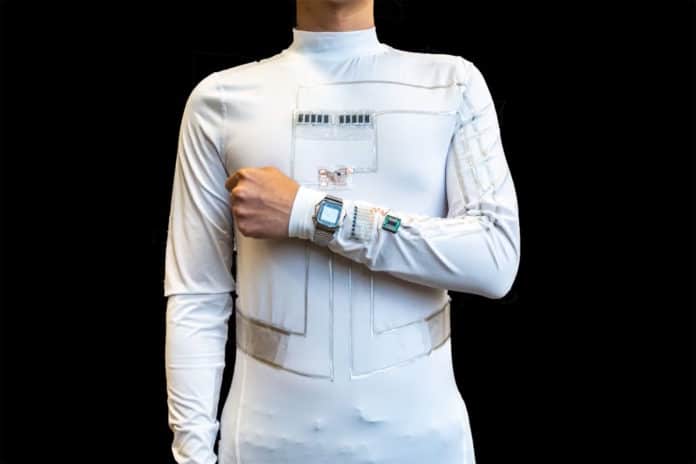Despite the rapid development of various energy harvesting and storage devices, their judicious integration into efficient, autonomous, and sustainable wearable systems has not been widely explored.
A team of engineers at the University of California, San Diego, has developed a “wearable microgrid” that harvests and stores energy from the human body to power small electronics.
The smart shirt consists of three main parts: sweat-powered biofuel cells, motion-powered devices called triboelectric generators, and energy-storing supercapacitors. All parts are flexible, stretchable, foldable, washable, and can easily be printed on textiles.
For their wearable microgrid, Ph.D. student Lu Yin and nanoengineering professor Joseph Wang combine flexible electronic components that they have printed on a T-shirt and positioned in such a way that optimal energy generation is achieved. For example, biofuel cells that harvest energy from sweat are located inside the shirt at the chest. Triboelectric generators, which convert energy from movement into electricity, are attached to the forearms and sides of the torso near the waist. They consist of a negatively charged piece on the inside of the forearm and a positively charged piece on the side of the torso. If your arms swing against the torso while walking or running, these pieces of material rub against one another. This generates electricity that is stored in the capacitor.
Harvesting energy from both movement and sweat enables the wearable microgrid to power devices quickly and continuously. The triboelectric generators generate energy as soon as the user begins to move, even before perspiration occurs. Once the user starts sweating, the biofuel cells come into play and, in turn, generate energy – even after the wearer stops moving.
To test the wearable microgrid, several 30-minute sessions were carried out with test subjects. Each of these consisted of a ten-minute stress exercise such as cycling or running, followed by 20 minutes of resting. The system was able to power either an LCD wristwatch or a small electrochromic display, a device that changes colors depending on the applied voltage, throughout the session.
Once developed further, the present version of the system could be useful for athletics and other cases where the user is exercising. But this is just one example of how the wearable microgrid can be used. “We are not limiting ourselves to this design. We can adapt the system by selecting different types of energy harvesters for different scenarios,” Yin said.
The engineers are working on other designs that can harvest energy while the user is sitting inside an office, for example, or moving slowly outside.
